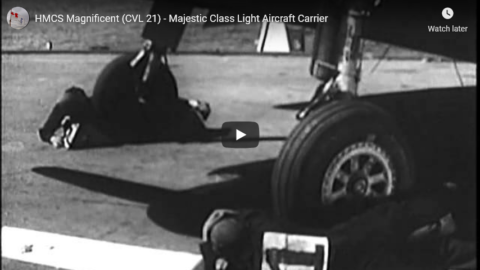canmildoc
Published 7 Apr 2013HMCS Magnificent (CVL 21) was a Majestic-class light aircraft carrier that served the Royal Canadian Navy from 1948-1957.
The third ship of the Majestic class, Magnificent was built by Harland and Wolff, laid down 29 July 1943 and launched 16 November 1944. Purchased from the Royal Navy (RN) to replace HMCS Warrior, she served in a variety of roles, operating both fixed and rotary-wing aircraft. She was generally referred to as the Maggie. Her aircraft complement included Fairey Fireflies and Hawker Sea Furies, as well as Seafires and Avengers.
Tags: HMCS Magnificent, CVL 21, Majestic Class Light Aircraft Carrier, Royal Canadian Navy, RCN, CV, Maggie, Fairey Fireflies, Hawker Sea Furies, Seafires, Avengers, Canada, aircraft carrier, Canada
From the comments:
Tibor80
5 years ago
That’s me with the mike in hand, interviewing the staff. It was the last TV work I did in Canada before leaving the industry and settling on Madison Avenue in the fall of 1954. Don Harron had been hosting a series titled ON THE SPOT, produced by NFB for 2-year old CBC-TV. They were running behind and NFB called me to fill in. I had never before done ad lib of this sort. They were supposed to have an advance man to do research and provide points to be covered or some sort of script but that never materialized. There was no crew either, so I doubled on grip work, hauled equipment from setup to setup — couldn’t do the camera and be in front of it, too — though I’m sure NFB would have loved that.I was just naturally very interested in the ship and asked a lot of questions and it worked out fine. The ship had no air conditioning. We were on maneuvers in the Gulf Stream near Bermuda in August. The heat was a killer. I couldn’t sleep. I shared a cabin with a lieutenant, a really nice fellow. He said, “Hey, Andy, you’re a V.I.P. here, I could get you a cot on a deck.” There was a little deck at the rear below the flight deck. All lights were out on maneuvers. I had never seen so many stars in my life — and the sea was filled with phosphorescence — like millions of fire flies. I thought I had died and gone to heaven.
We only had one week on the Maggie making the documentary but I was tempted to sign up for life. The navy had turned me down once before. A buddy and I got terrible marks in high school in the spring ’45 so we ran down to the Navy Recruiting station in Toronto and asked to sign up. A wiseguy behind the desk said, “Leave your names and if Hitler attacks Toronto, we’ll give you a call.” (Hitler shot himself a week later)
A video editor friend up in Belleville found this video and wrote to me saying there was a fellow with my name in this video. I told him that was me 70 pounds ago. Great days.
The Wikipedia entry says:
HMCS Magnificent (CVL 21) was a Majestic-class light aircraft carrier that served the Royal Canadian Navy from 1948–1957. Initially ordered by the Royal Navy during World War II, the Royal Canadian Navy acquired the carrier as a larger replacement for its existing operational carrier. Magnificent was generally referred to as Maggie in Canadian service. Following its return to the United Kingdom in 1956, the ship remained in reserve until being scrapped in 1965.
Description and construction
The 1942 Design Light Fleet carrier was divided into the original ten Colossus-class ships, followed by the five Majestic-class ships, which had some design changes that accommodated larger and heavier aircraft. The changes reduced the weight of petrol and fuel storage by reducing them to 75,000 gallons, to offset the additional weight from strengthening of the deck to operate aircraft as heavy as 20,000 pounds (9,100 kg). Further improvements over the Colossus class included larger aircraft elevators (54 by 34 feet, 16 m × 10 m) and improvements made to internal subdivisions for survivability purposes and accommodations.
The ship was 698 feet (212.8 m) long with a beam of 80 ft (24.4 m) and a draught of 25 ft (7.6 m). The carrier displaced 15,700 long tons (16,000 t). The ship was powered by steam from four Admiralty three-drum boilers. This propelled two Parsons geared steam turbines driving two shafts creating 40,000 shaft horsepower (30,000 kW). Magnificent had a top speed of 24 knots (44 km/h; 28 mph).
The aircraft carrier was armed with 24 2-pounder and 19 Bofors 40 mm guns for anti-aircraft defence. Majestic-class carriers were fitted out with Type 281, Type 293 and two Type 277 radar installations. The ship had a complement of 1,100, including the air group.
The third ship of the Majestic class, Magnificent was ordered 16 October 1942. The order was placed with Harland and Wolff in Belfast who were also constructing the Colossus-class ships Glory and Warrior. Magnificent was laid down on 29 July 1943 with the yard number 1228 and launched on 16 November 1944.







